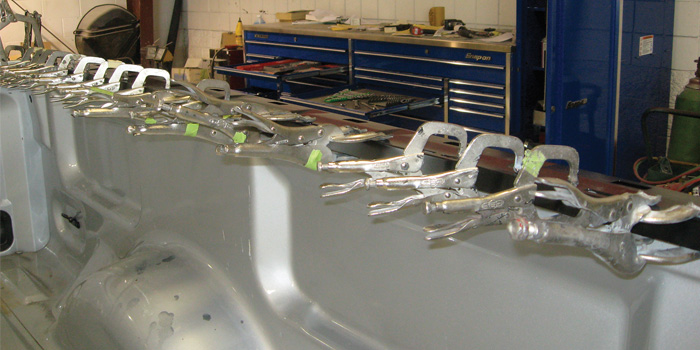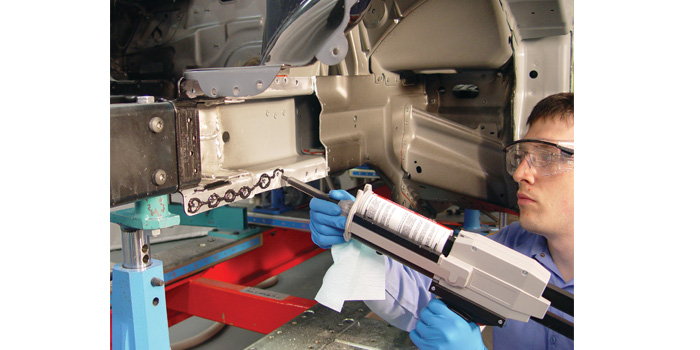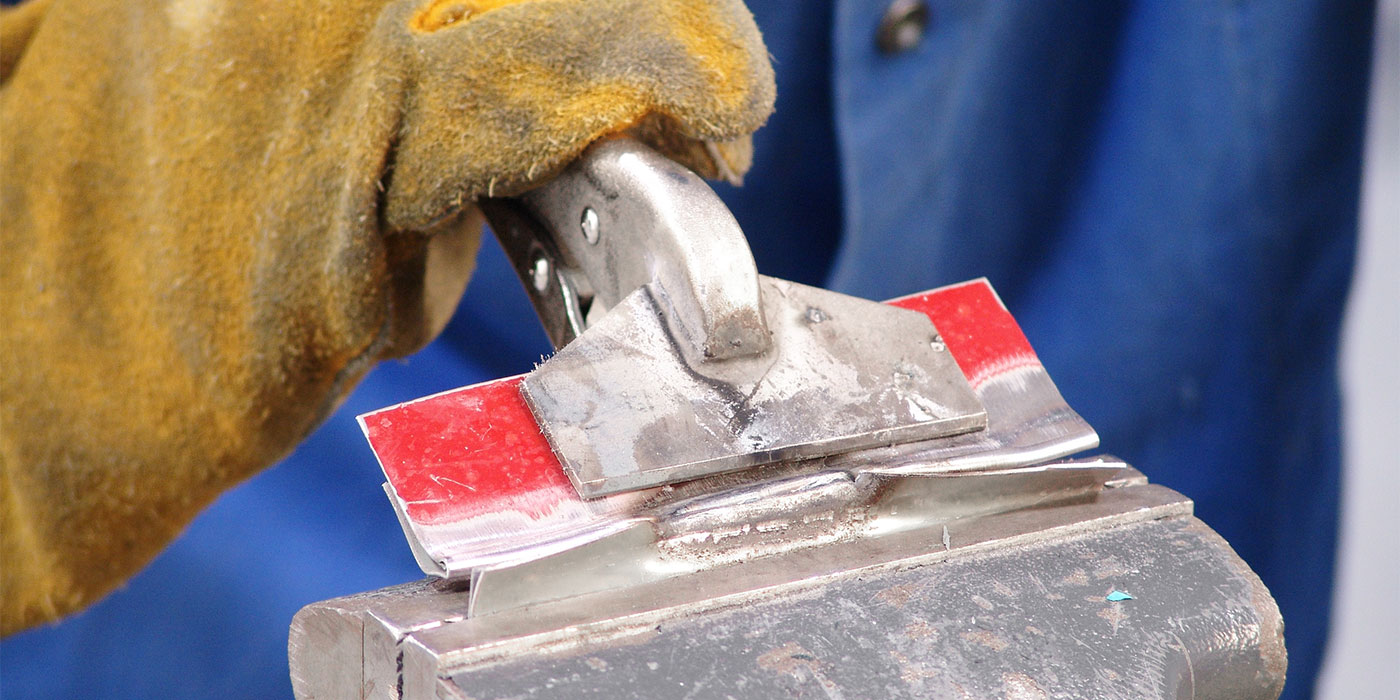In the collision industry, we need to know a lot of information. We also find ourselves trying to keep up with changes in repair procedures and new features in vehicles. The task is daunting to anyone. I often say I know less today than I did yesterday.
In this need and quest for knowledge, sometimes we need to take a look and see if we’re forgetting something. Also, in the quest for cycle time, we may make a decision to do or not do a procedure. This doesn’t mean it is wrong, as it was an option on which way to do the repair. An example would be on squeeze type resistance spot welding or MIG welding.
After years of talking with experts and engineers, I find that common sense is typically the reason vehicle manufacturers recommend certain procedures. Then you get, “Oh, I didn’t think of that.” In the quest for reducing weight and meeting new safety requirements, we see more and more of the, “But there is more.”
Adhesives
Adhesives are wonderful products that seem to always have a “But there is more” story.
We know we bond two different substrates together, that’s a given. But how and what strength surprises many. Another factor is it may not be just bonding but controlling or adding to a property. A great example is weld bonding. Yes, it does add strength to the welded panels, but it also offers corrosion protection along with reducing noise, vibration and harshness – proof that adhesives do a great deal more than we see.
We see adhesives that bond metal to metal. We also see adhesives that bond metal to plastic, glass to metal, plastic to plastic, plastic to glass, PVC to metal…the list goes on and on. What’s interesting to me is that one product can’t do it all. This leads to a repair shop having to carry multiple types of adhesives for different applications.
Many people assume all adhesives work the same. In the repair industry, that’s a dangerous train of thought. Even the differences between companies with similar products can be vast. With the variety of polyurethanes out there, epoxies and other synthetics give each adhesive the desired properties for adhesion and function.
Some folks will call them glues, a term adhesive companies cringe at. Although it’s only semantics, they’ll correct you and say, “It’s an adhesive, not a glue.” For you trivia buffs, what’s the difference? According to a friend who engineers the stuff, glues are natural products, whereas adhesives are made from synthetic materials.
Adhesives are basically components that adhere two surfaces together. They’re not to be confused with sealers that don’t bond but seal the areas between two surfaces.
Strengths
Adhesives can be made to various strengths and/or a combination. One measurement would be tensile strength or the forces pulling away from the surface. Another is lap shear, or the forces of surfaces moving in opposing directions sideways.
 Another measurement used heavily in automotive is peel strength, similar to starting at an end and peeling the tape off.
Another measurement used heavily in automotive is peel strength, similar to starting at an end and peeling the tape off.
Two other stresses measured are cleavage and compressive. Where it is used in the vehicle dictates what strength is desired. This also dictates what adhesive should be used where in the repair of a vehicle.
Using just any old adhesive is not in the best interests of anyone. Vehicle crash dynamics could be greatly altered as could the vehicle life. Using an adhesive in the wrong location could present a serious liability to a shop.
Adhesive-only bonding is available for some applications. The problem is that the adhesives may have a weakness and require a mechanical bond along with adhesive. This is why we see rivet bonding, or weld bonding, where there is the need for the combination of both to withstand severe crash forces. Or it might just be that everyday stress is an issue. This is why there is a broad industry statement that says no panel bonding only is to be done on many components of vehicles unless there is a procedure. This prevents failures in everyday driving and crashes.
Failures
How do you know your adhesive failed you? You need to know what you are seeing. There are two basic modes:
Adhesive failure. The two bonded substrates have separated and one surface has no signs of material on the surface.
Cohesive failure. When the two surfaces have pulled apart and the adhesive product remains intact on both surfaces but separates in the material itself.
Failures happen for a variety of reasons:
- Improper surface preparation Primer is wrong or never used
- A primer may also have been used when it should not have Improper mixing if required
- Wrong product for application
- Expired product
- Failure to wait cure times
- Mixing of dissimilar products
Identifying failures when they occur is critical to a shop. Quality control of products and use of products is a big part of successful repairs. When doing bumper repairs and seeing failures, it’s critical to your shop’s reputation to know where the failure is.
Preventing Failures
All adhesives have a degree of surface preparation to prevent failure. Whether it needs to be bare metal as some panel bonds require, or 1 to 2mm of urethane adhesive left on a pinchweld, the importance of following directions is crucial. Technicians should seek out training or watch a product demonstration before using it themselves. 3M and other companies have great videos on their website and all over YouTube that you can watch.
Know your product. Knowing which mixing tip is required and how to apply it on surfaces will result in a quality repair and hopefully not create more work or a longer repair. I laugh when I here people say, “Don’t wash the car after the glass is bonded in place with urethane adhesive!” I say wash the car! Water speeds the cure because it’s a moisture cure product. If a car wash is an issue, you shouldn’t be driving the vehicle.

Know your strengths. Using the wrong adhesive for structural repairs will be a problem. I say this as new structural adhesives are and have been developed and are being used already in new vehicles. Watch the color of adhesive for new structural versions.
Don’t skip them. It does take more time to weld bond panels on vehicles which, to many technicians, seems like a waste of time. I always tell techs they did it for a reason. You may not understand it but it is there. If they could have saved the money and left it out of millions of vehicles, they would have. I also tell techs who skip this step to remember that the weld has to last the life of the car. The reduction of stress on the weld from everyday driving and the sealing properties for corrosion are important too. Adhesives do much more than most realize.
Know Your Stuff
Making sure adhesives are being used and being used correctly requires a great deal of communication. Keeping up with procedures for success and identifying where problems have occurred is something we must strive for every day.
If a vehicle used weld bonding, use weld bonding during the repair if possible. It may take more time but it’s well worth the quality and corrosion protection. Whether its adhesion promotors or primers or even flame, be sure all techs know what procedures are required. Once you know, it’s hard to ignore the benefits.














